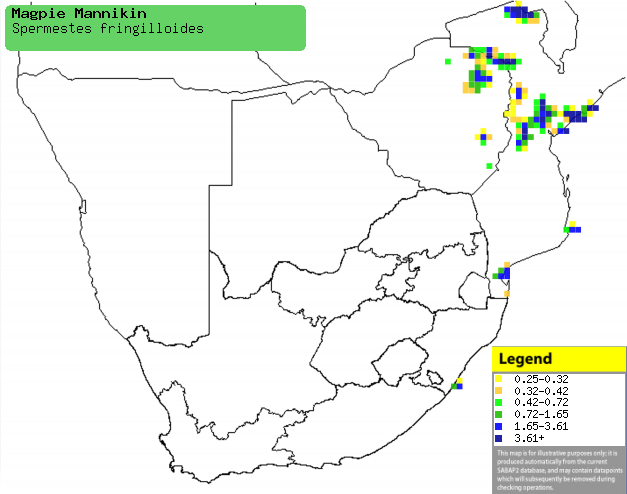|
Spermestes fringilloides
(Magpie mannikin, Pied mannikin)
Dikbekfret [Afrikaans]; Reuzenekstertje [Dutch];
Capucin pie [French]; Riesenelsterchen [German]; Freirinha-maior
[Portuguese]
Life
> Eukaryotes >
Opisthokonta
> Metazoa (animals) >
Bilateria >
Deuterostomia > Chordata >
Craniata > Vertebrata (vertebrates) > Gnathostomata (jawed
vertebrates) > Teleostomi (teleost fish) > Osteichthyes (bony fish) > Class:
Sarcopterygii (lobe-finned
fish) > Stegocephalia (terrestrial
vertebrates) > Tetrapoda
(four-legged vertebrates) > Reptiliomorpha > Amniota >
Reptilia (reptiles) >
Romeriida > Diapsida > Archosauromorpha > Archosauria >
Dinosauria
(dinosaurs) > Saurischia > Theropoda (bipedal predatory dinosaurs) >
Coelurosauria > Maniraptora >Aves
(birds) > Order: Passeriformes
> Family: Estrildidae
For information about this species, see
birdinfo.co.za.
Distribution and habitat
Occurs in patches scattered across sub-Saharan Africa, with
the bulk of its population occupying the area from Cameroon to northern Angola,
southern DRC, Zambia and southern Africa. Here it is uncommon in northern,
central and southern Mozambique, eastern Zimbabwe and locally in and around
Anerley and Port Shepstone, KwaZulu-Natal, in fact it is thought to be the
rarest breeding bird in South Africa.
|
 |
|
Distribution of Magpie mannikin in southern
Africa, based on statistical smoothing of the records from first SA Bird
Atlas Project (©
Animal Demography unit, University of
Cape Town; smoothing by Birgit Erni and Francesca Little). Colours range
from dark blue (most common) through to yellow (least common).
See here for the latest distribution
from the SABAP2. |
Predators and parasites
Nestlings have been recorded as prey of snakes and
Polyboroides typus (African
harrier-hawk, Gymnogene).
Food
It generally prefers seeds taken directly from grasses,
especially bamboo, supplemented with insects. The following food items have been recorded
in its diet:
- Seeds
- grasses
- Oxytenanthera abyssinica (Bindura bamboo)
- species eaten in captivity
- Poa annua (Annual bluegrass)
- Eragrostis curvula (Weeping lovegrass)
- Panicum maximum (Guinea grass)
- Panicum schinzii (Sweet grass)
- Sporobolus fimbriatus (Dropseed grass)
- Sorghum halepense (Johnson grass)
- Sorgum versicolor (Black-seed sorghum)
- Bidens pilosa (Common blackjack)
- Schkuhria pinnata (Dwarf marigold)
- Insects
Breeding
- The nest is built by both sexes in about 7-10 days, consisting of an
oval-shaped structure with a side entrance, made of coarse grass stems and
lined with fine bamboo flowers, feathers, grass inflorescences and green
Asparagus stems. It is typically placed in a bush, tree or bamboo
thicket, approximately 1.2-5 metres above ground.
- Egg-laying season is from October-July, peaking from about
December-April.
- It lays 4-7 eggs, which are incubated for 14-16 days (recorded in
captivity).
- In captivity the chicks stay in the nest for about 19-22 days.
Threats
Not threatened globally, but Near-threatened in
South Africa, partly due to its dependence on bamboo for food which is not
common in KwaZulu-Natal.
References
-
Hockey PAR, Dean WRJ and Ryan PG 2005. Roberts
- Birds of southern Africa, VIIth ed. The Trustees of the John Voelcker
Bird Book Fund, Cape Town.
-
Harrison, J.A., Allan, D.G., Underhill, L.G., Herremans, M.,
Tree. A.J., Parker, V. & Brown, C.J. (eds). 1997. The atlas of southern
African birds. Vol. 2: Passerines. BirdLife South Africa, Johannesburg.
|
